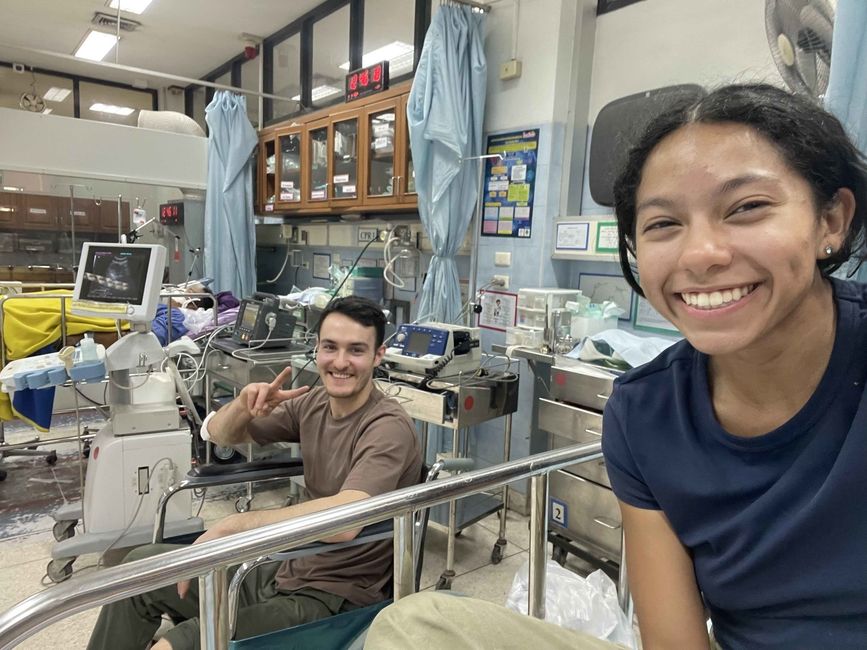Medical Care in Thailand and What to Expect
When moving to Thailand for anywhere between six months and a year, you will likely encounter the need for medical care. I have found myself needing more medical attention in Thailand than I did back in the US. I have a few hypotheses for why this is:
- I interact with about 300-350 people weekly, including my 240 students, teachers, friends, and more. Germs spread like wildfire in a school.
- I have a different diet here, and adjusting to Thai food with different ingredients including spicy seasonings, can lead to stomach issues.
- The stress of moving and adjusting to a new country does impact your immune system. When I pair this adjustment with how much I travel and the stress this puts on my body, my immune system is likely not the strongest.
Nonetheless, my goal for this post is to share some of the medical issues I’ve dealt with, what the finances look like, how to seek care, and my last pieces of advice. Let’s get started!
Minor Illnesses and Treatment
Since moving to Thailand, I get sick about once every six weeks in what I would categorize as inconvenient sickness. This includes traveler’s diarrhea (I’ve gotten this twice) and the common cold (I’ve gotten this three times). These were not very extreme sicknesses, mainly just annoyances. For these illnesses, I just used over-the-counter medication. Below is a rundown of where you can go to treat these illnesses.
7-Eleven
At 7-Eleven, you will find a small section to help you recover from various illnesses. Typically these are natural remedies They have some medicine to treat diarrhea, constipation, headaches (they sell Tylenol, though not Ibuprofen), and cough drops.
Pharmacies
If 7-Eleven doesn’t have what you are looking for, your next stop will be going to the pharmacy. You can shop at local or name-brand pharmacies like Watson’s or Boots. Watson’s is considered a health and beauty shop, so they emphasize vitamins, skin care products, and more. However, Watson’s has a pharmacy section, though your ability to access the pharmacy depends on whether a pharmacist is working when you are there (I have not always had success). Boot’s is very similar to Watson’s, though typically smaller. My experience with Boots has been that since it is smaller, it focuses more on the pharmacy aspect, though it is also a great place to go for health and beauty.
You can also shop at local pharmacies since they will likely be more convenient. There are two pharmacies near me, and it takes 15-20 minutes to walk to them. There, you can get medicine to treat the specific symptoms of your illness, like a cough, sore throat, or runny nose.
I will admit that the type of medicine you receive at pharmacies aims at treating symptoms and not causes. That was a shift from my experience in the US, where normally, any sickness I had started with identifying what it was: the flu or the common cold. You typically buy cold or flu medicine aimed at your symptoms. However, when I got the cold in Thailand, I could not get “cold medicine,” only medicine to treat each symptom separately (so lots of pills).
Finances
Usually, over-the-counter medication is cheap. I get 10 (500 mg) Tylenol pills from 7-Eleven for maybe a dollar. The first time I went to the pharmacy, I got three different medications to help treat symptoms and spent less than 200 baht ($5.46).
Doctor’s Appointments and Vaccines
Japanese Encephalitis Vaccine
To get this vaccine, I went to Bangkok Hospital and spent an afternoon there. I didn’t need an appointment, I just walked in (bring your passport!) and then had a consultation with the doctor about the immunizations I should get, got my Japanese Encephalitis vaccine, and was on my merry way. For this entire visit, it cost me approximately 2,000 baht. My friend, who also got the rabies vaccine, paid 1,100 baht more for hers (I had gotten my preventative rabies shots a few years ago).
Dentist Appointment
At my appointment, I needed to get a cavity filled and have my teeth cleaned. This cost me 2,700 baht, and I felt satisfied with my care! My dentist spoke English well, and I didn’t notice a major difference between the care I received in the US and the one I received in Thailand. Though it didn’t happen to me, I also knew a girl who needed to get one of her wisdom teeth removed while she was here, and I remember that it cost her just over 3,000 baht.
Medical Emergencies
Time to get a little serious here. Thus far, I have been to the hospital twice with more serious medical emergencies. I’ll start with my most recent experience and then my most serious.
Most recently, I went to the hospital because of COVID-like symptoms, though I tested negative twice during at-home tests. I decided to eventually drive to the hospital when I realized I had a 102-degree fever, which I had been going in and out of for 48 hours. At the hospital, I tested negative for COVID-19 and the flu. After establishing this, I had chest X-rays done to see if there was a more serious problem. Thankfully, it was nothing too serious, and my doctor concluded I most likely had the beginning stages of bronchitis. Since it was a bacterial form, the hospital gave me antibiotics through an IV, then gave me lots of medicines to take home, which included antibiotics, two chest decongestant medications, one cough medicine, and Tylenol. This trip was much more expensive than I expected, for a total of 7,800 baht (though fully covered by insurance). From my understanding of the bill, the most expensive part was the medicine they prescribed me.
My most serious medical emergency (sorry Mom and Dad if you read this!) was after a minor motorbike accident. I say minor because there wasn’t a major collision, but I was thrown off my bike, and due to the shock of the accident and the adrenaline pumping through my body, I could not stand up without my vision turning dark. The national park called an ambulance and my boyfriend and I went to the emergency room where they cleaned up both of our wounds (he was on a different motorbike that also crashed), gave us x-rays, and did an ultrasound on me to check for any damage to organs (thankfully none). After a few long hours in the ER, we were both left with sore bodies, some skin-surface wounds, and a sprained ankle for me. Scary, but thankfully not serious (cue the collective exhale).
What's crazier is that my hospital bill was 1,800 baht (also paid for by my insurance). One note I want to make is that surprisingly, the hospital did not charge me for the ambulance. We looked at my and my boyfriend’s bill, and nowhere could we find a charge for the ambulance (which ended up being about a 50-minute drive). Maybe this changes regionally in Thailand, but my experience is that it was free!
Insurance with iNext
As part of the program fee for CIEE Teach in Thailand, you get one year of international medical insurance (even if your program is for six months). The insurance is used more or less only for emergency medical care since routine physicals, non-emergency dental and vision care, and preventative medicine are not in the insurance plan.
However, for my two trips to the hospital that were emergencies, I did get full coverage pretty quickly. While I was at the hospital, I had to pay the amount out of pocket, then afterward used the receipts and medical documents the hospital gave me to file a claim. Here is exactly how I did it.
- I went online to iNext Files and Claims and downloaded the form for my policy number. My policy number began with CC, so I clicked this. I found my policy number by searching my email for information on iNext insurance.
- After this, you have to choose the proper form, which should be pretty self-explanatory. I will include all the potential forms you can choose from, just for your reference. The one you will use for medical emergencies is the “medical expense form,” but you can also file a claim for “trip cancellation, trip delay, trip interruption,” and “baggage and personal effects'' (which is if anything gets stolen or lost).
- Fill out your respective form. You will need your iNext policy number, your insurance policy number in the US, the dates of your treatment, and the contact information of the institute that treated you.
- Send the completed form, copies of all medical documents (including your receipt) from the hospital, and a copy of your insurance card from the US to travelteam@cbpinsure.com. For the subject of my email, I labeled it “Motorbike Accident Insurance Claim: Policy Number CC____-__-_______.”
- Wait to get your reimbursement. For my motorbike accident, it took nine days from the time I sent my claim to the time that reimbursement hit my bank account. For my bronchitis hospital visit, it took seven days. Technically, it can take up to a couple of months to get this reimbursement, but my experience is that they are fast and efficient. An important note about the reimbursement is that you will receive it in US dollars, NOT Thai baht. I paid all my expenses using my Thai bank account, but now I have that money in US currency instead. In terms of the conversion rate, they err on giving you a better conversion rate (maybe a couple of dollars more), but it tends to be very accurate.
Last Notes and Tips
Healthcare in the US and Thailand
I have noticed some differences in health care between Thailand and the US. Some things I’ve noticed are:
- Antibiotics are available over the counter, so they are much more willing to use them in treatment in Thailand.
- A lot more medicines are available over the counter here than in the US (which I found helpful not needing to have a prescription)
- The doctor’s office exists in the hospital. In the US, if you say you are going to the hospital, it implies the emergency room or some emergency. In Thailand, the hospital and doctor's office are in the same place, so you will make medical appointments at the hospital.
- All pain relievers come in higher dosages. In the US, I take 400 mg of Ibuprofen for a headache, and for mild headaches, I take only 200 mg. Here, the actual smallest single pill dosage of Ibuprofen I can get is 300 mg, and I still have to break apart the 600 mg pill. Tylenol at 7-Eleven is 500 mg. The dosage is strong here.
- Ibuprofen is NOT sold at 7-Eleven, so you will need to get it at a pharmacy.
The medicine I would recommend bringing
- Cold medicine like DayQuil or Nyquil
- Sudafed (this is not available over the counter and requires an appointment in Thailand)
- Pepto Bismol and Imodium (I think they have these here but I have not had luck finding them in the pharmacy)
- Tums (not available here)
Related Posts

A Day in My Life Teaching Kindergarten
Before moving overseas, one question that constantly circled my mind was: What will my everyday life look like? I had lots of ideas, but I quickly realized it's impossible to... keep reading

One Month in Thailand: The Stages of Adjustment
Coming up on my one month of living and working in Thailand, here are some of my tips and tricks for adjusting to your new life here (based on my experience)

A School Day in My Life Teaching Pre-K
A month or so before moving to Thailand, I got the email that I was assigned to teach pre-kindergarten. I was ecstatic – I’d been hoping I’d get placed working... keep reading

